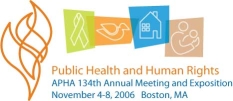 Back to Annual Meeting
|

|
 Back to Annual Meeting
|
APHA Scientific Session and Event Listing |
 Back to Annual Meeting
|

|
 Back to Annual Meeting
|
APHA Scientific Session and Event Listing |
Karin A. Mack, PhD, Julie Gilchrist, MD, and Michael Ballesteros, PhD. Division of Unintentional Injury Prevention, CDC Injury Center, 4770 Buford Hwy NE K63, Atlanta, GA 30341, 7704884389, kmack@cdc.gov
Purpose Unintentional injury in infants has been reported largely with product specific studies. We present a more comprehensive profile of non-fatal unintentional injuries in infants.
Methods Data come from the 2001-2004 NEISS-AIP (http://www.cdc.gov/ncipc/wisqars/nonfatal/datasources.htm), which is a stratified probability sample of all US hospitals having ≥six beds and providing 24-hour emergency services. Data elements include diagnosis, body part injured, cause, age (in months), month/day of visit, disposition, location, product involvement, gender and a brief narrative. Estimates were weighted and analyzed with SPSS complex samples.
Results An estimated 328,534 infants age 0-12 months visit emergency departments annually to receive treatment for unintentional injuries. The leading cause was fall related injury. The most frequent diagnosis was contusion/abrasion (26.7% 95%CI=23.2-30.6%), followed by laceration (17.2% 95%CI=15.3-19.4%) and internal injury (16.8% 95% CI=13.5-20.6%). Younger infants were more likely to be hospitalized than older ones. The proportion of cases with a traumatic brain injury classification was highest in 3 month old infants (29.3% 95%CI=22.6-37.1%) and lowest in 12 month old infants (11.0% 95%CI=2.9-13.6%). For every month of age except 2 and 12 months, beds were the most frequently involved product.
Conclusions Results show that every minute and a half an infant is seen in an emergency department for an unintentional injury. Research on injuries in children as a group ignores the potential variation in type of injury risk as children's developmental abilities change. Developmental milestones (including mobility, hand coordination, and grasp) should be considerations when developing injury prevention strategies among infants.
Learning Objectives:
Keywords: Injury, Infant Health
Related Web page: www.cdc.gov/ncipc
Presenting author's disclosure statement:
Not Answered
The 134th Annual Meeting & Exposition (November 4-8, 2006) of APHA